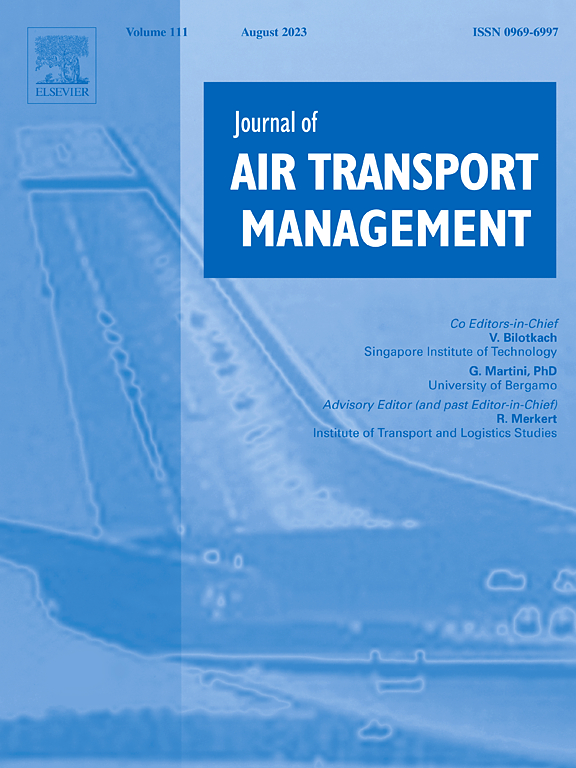基于两步预见冲突解决的图模型分析航空公司网络选择竞争
IF 3.6
2区 工程技术
Q2 TRANSPORTATION
引用次数: 0
摘要
网络结构的选择是航空公司在市场竞争中取得优势的重要手段。在现有的研究中,利用博弈论的方法为竞争中的策略建议提供均衡。如今,航空公司的公用事业越来越多地受到难以校准的因素的影响,例如地缘政治事件。此外,作为明智的决策者,航空公司不仅要考虑一步的战略举措,还要考虑对手航空公司可能采取的反击措施。本文采用冲突解决图模型(GMCR)这一解决战略冲突的有效方法,对竞争两家航空公司之间的网络结构选择进行了研究。竞争均衡的计算不要求明确表达效用,并分两步反映各航空公司的感知。给出了竞争均衡存在的定理,包括纳什均衡和两步前瞻的顺序稳定均衡。与已有文献在相同模型设置下计算的均衡相比,GMCR所提出的纳什均衡与经典博弈论方法计算的纳什均衡基本一致。此外,GMCR可以表明SEQ均衡是对竞争的更好理解,反映了决策者更长远的远见。特别是,本文情景1和情景2中的SEQ均衡表明,与纳什均衡建议的策略相比,采用两家航空公司都可以更有利可图的替代策略。如本文所示,GMCR不仅在建模上需要更少的信息,而且能够为航空业的决策经理提供更有洞察力的策略。此外,利用GMCR解决网络选择问题的框架可以为未来航空业更广泛的战略竞争问题的分析提供一个有用的范式。本文章由计算机程序翻译,如有差异,请以英文原文为准。
Analyzing network selection competition between airlines using Graph Model for Conflict Resolution in the foresight of two steps
The selection of network structures is instrumental for airlines to gain upper hand in market competition. In the existing research, game theoretical methodologies are utilized to provide equilibria for suggesting strategies in competition. Nowadays, utilities for airlines are increasingly affected by factors which are difficult to calibrate, such as geopolitical events. Besides, airlines as wise decision makers not only consider the strategic moves in the foresight of one step, but also what could be the counteractions from opponent airlines. In this paper, the selection of network structures between two competing airlines are investigated using graph model for conflict resolution (GMCR), an effective methodology for solving strategic conflicts. The equilibria of competition are calculated without the requirement of explicit expression of utilities, and reflecting the perception of each airlines in two steps. Theorems are provided to indicate the existence of the equilibria in the competition, including Nash equilibria and sequentially stable (SEQ) equilibria for the foresight of two steps. Comparing with the equilibria calculated in the existing literature based on the same modelling settings, the Nash equilibria suggested by GMCR are consistent with those calculated by classical game theory approach. Besides, GMCR can indicate SEQ equilibria as an enhanced understanding of competition reflecting longer foresights of DMs. In particular, the SEQ equilibria in Scenarios 1 and 2 of this paper indicate alternative strategies by adopting which both airlines could be more profitable compared with the strategies suggested by Nash equilibria. As demonstrated in this paper, GMCR not only requires less information in modelling, but is also capable of providing more insightful strategies for DMs in aviation industry. Moreover, the framework of addressing the network selection problem using GMCR could provide a useful paradigm for analyzing wider range of strategic competition problems in aviation industry in the future.
求助全文
通过发布文献求助,成功后即可免费获取论文全文。
去求助
来源期刊

Journal of Air Transport Management
TRANSPORTATION-
CiteScore
12.40
自引率
11.70%
发文量
97
期刊介绍:
The Journal of Air Transport Management (JATM) sets out to address, through high quality research articles and authoritative commentary, the major economic, management and policy issues facing the air transport industry today. It offers practitioners and academics an international and dynamic forum for analysis and discussion of these issues, linking research and practice and stimulating interaction between the two. The refereed papers in the journal cover all the major sectors of the industry (airlines, airports, air traffic management) as well as related areas such as tourism management and logistics. Papers are blind reviewed, normally by two referees, chosen for their specialist knowledge. The journal provides independent, original and rigorous analysis in the areas of: • Policy, regulation and law • Strategy • Operations • Marketing • Economics and finance • Sustainability
 求助内容:
求助内容: 应助结果提醒方式:
应助结果提醒方式:


